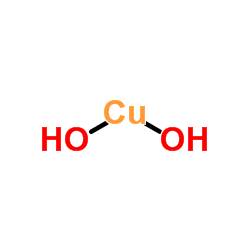The Goldilocks principle in action: synthesis and structural characterization of a novel {Cu4(μ3-OH)4} cubane stabilized by monodentate ligands.
G Attilio Ardizzoia, Stefano Brenna, Sara Durini, Bruno Therrien, Ivan Trentin
Index: Dalton Trans. 42(34) , 12265-73, (2013)
Full Text: HTML
Abstract
A {Cu4(μ3-OH)4} compound, where four copper(II) and four μ3-bridging oxygen atoms occupy alternate corners of a slightly distorted cube, has been prepared and structurally characterized. This species, formulated as [Cu4(μ3-OH)4(Htmpz)8](ClO4)4·1.5Et2O (Htmpz = 3,4,5-1H-trimethyl pyrazole), can be classified as belonging to type I Cu4O4 cubane complexes, and is better described as two Cu(II)-(μ-OH)2-Cu(II) units held together by four long Cu-O bonds. The central distorted cubane core is stabilized by neutral monodentate ligands (Htmpz) and perchlorate anions, as demonstrated by single-crystal X-ray structure analysis. The title compound was obtained by hydrolysis of a dinuclear methoxo-bridged species, [Cu(μ-OCH3)(Htmpz)2]2(ClO4)2, which was prepared by reaction of [Cu(Htmpz)4(ClO4)2] with methanol. All these reactions represent a nice example of the Goldilocks principle in action in coordination chemistry, since each single actor (solvent, counteranion, and ligand) has the "just right" electronic, steric or coordinative properties which determine the fate of the final products.
Related Compounds
| Structure | Name/CAS No. | Molecular Formula | Articles |
|---|---|---|---|
 |
Cupric hydroxide
CAS:20427-59-2 |
Cu.(OH)2 |
|
Synthesis of hierarchical three-dimensional copper oxide nan...
2013-09-07 [Nanoscale 5(17) , 7991-7, (2013)] |
|
Physical and chemical control of released microorganisms at ...
1991-09-01 [Can. J. Microbiol. 37(9) , 708-12, (1991)] |
|
Continuous biotreatment of copper-concentrated solutions by ...
2006-01-01 [Appl. Biochem. Biotechnol. 128(1) , 23-32, (2006)] |
|
Corrosion investigation of two materials for implant supraco...
1991-04-01 [Scand. J. Dent. Res. 99(2) , 181-6, (1991)] |
|
[Coprecipitation of proteins and DNA-protein complexes with ...
1989-01-01 [Izv. Akad. Nauk SSSR Biol. (1) , 148-51, (1989)] |